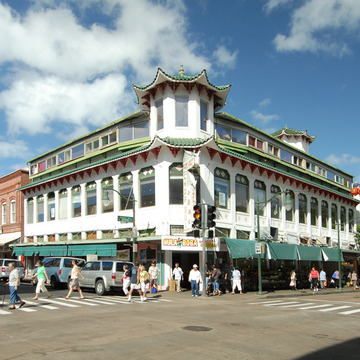Wo Fat Restaurant explicitly embraces a “Chinese” style. A rarity within Honolulu's Chinatown, its dramatic, neon lit, pagoda-like tower frequently stands as a touchstone image of the district. The strong heritage statement is augmented by a tiled roofline and fretted transom windows. A second tower, which was part of a rooftop pavilion, was unsympathetically expanded to form an enclosed third floor. The restaurant was one of a number of Asian-styled buildings designed by Honolulu architect Yuk Tong Char. Other buildings included the Lau Yee Chai restaurant in Waikiki (1929), Chungshan Chinese Language School (1935), and Korean Christian Church (1938), all demolished, as well as Hilo Chinese Church (HA44). Born in Waipahu in 1890, Char graduated from Mills Institute (later Mid-Pacific Institute), and then in 1915 from Cornell University's department of architecture. For a number of years, he worked as a draftsman in the offices of Guy Rothwell and Herbert Cohen Cayton before opening his own practice in the 1930s.
You are here
Wo Fat Restaurant
If SAH Archipedia has been useful to you, please consider supporting it.
SAH Archipedia tells the story of the United States through its buildings, landscapes, and cities. This freely available resource empowers the public with authoritative knowledge that deepens their understanding and appreciation of the built environment. But the Society of Architectural Historians, which created SAH Archipedia with University of Virginia Press, needs your support to maintain the high-caliber research, writing, photography, cartography, editing, design, and programming that make SAH Archipedia a trusted online resource available to all who value the history of place, heritage tourism, and learning.


